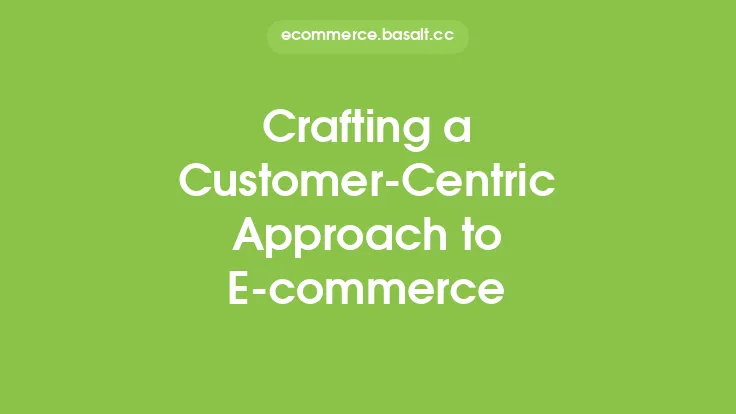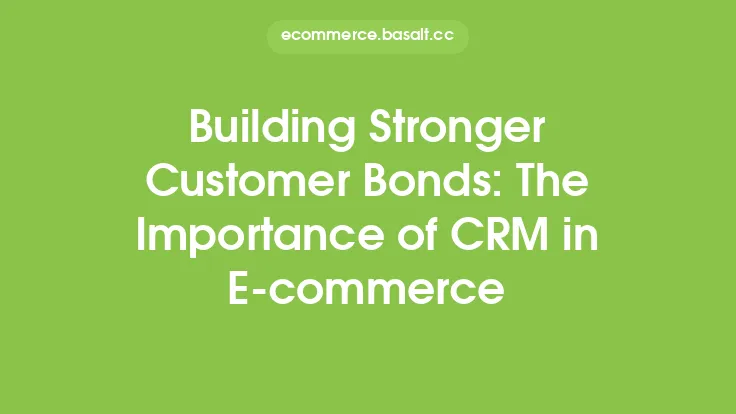In today's competitive e-commerce landscape, building a customer-centric strategy is crucial for driving business growth, increasing customer loyalty, and ultimately, boosting revenue. A customer-centric approach focuses on understanding the needs, preferences, and behaviors of customers, and using that information to create personalized experiences that meet their expectations. In this article, we will explore the key elements of a customer-centric e-commerce strategy and provide insights on how to implement it effectively.
Understanding Customer Needs and Preferences
To build a customer-centric e-commerce strategy, it's essential to have a deep understanding of your target audience. This includes gathering data on their demographics, shopping habits, and preferences. You can collect this information through various means, such as customer surveys, social media analytics, and purchase history. By analyzing this data, you can identify patterns and trends that will help you create targeted marketing campaigns, personalized product recommendations, and tailored customer experiences.
Creating a Seamless User Experience
A seamless user experience is critical to keeping customers engaged and satisfied. This includes ensuring that your website is easy to navigate, has a clean and intuitive design, and is optimized for mobile devices. You should also prioritize fast loading speeds, secure payment processing, and clear product information. Additionally, consider implementing features such as product reviews, customer testimonials, and social proof to build trust and credibility with your customers.
Personalization and Tailored Recommendations
Personalization is a key aspect of a customer-centric e-commerce strategy. By using data and analytics, you can create tailored product recommendations, offer personalized promotions, and provide customized content that resonates with your customers. This can be achieved through various techniques, such as collaborative filtering, content-based filtering, and hybrid approaches. Personalization can help increase customer engagement, drive conversions, and foster loyalty.
Building Strong Relationships through Communication
Effective communication is vital to building strong relationships with your customers. This includes responding promptly to customer inquiries, providing clear and concise product information, and keeping customers informed about their orders and shipping status. You should also consider implementing a loyalty program, offering exclusive discounts, and providing personalized support to loyal customers. By building trust and rapport with your customers, you can increase customer retention and encourage positive word-of-mouth.
Measuring and Optimizing Customer Satisfaction
Measuring customer satisfaction is crucial to understanding the effectiveness of your customer-centric e-commerce strategy. You can use various metrics, such as customer satisfaction surveys, net promoter scores, and customer retention rates, to gauge customer satisfaction. By analyzing this data, you can identify areas for improvement and optimize your strategy to better meet the needs and expectations of your customers. This includes refining your product offerings, improving your user experience, and enhancing your customer support.
Leveraging Technology to Enhance Customer Experience
Technology plays a vital role in enhancing the customer experience. You can leverage various tools and platforms, such as customer relationship management (CRM) software, marketing automation platforms, and data analytics tools, to gain insights into customer behavior, personalize marketing campaigns, and optimize customer interactions. Additionally, consider implementing emerging technologies, such as artificial intelligence (AI) and augmented reality (AR), to create immersive and interactive experiences that engage and delight your customers.
Fostering a Customer-Centric Culture
A customer-centric culture is essential to driving a successful e-commerce strategy. This includes instilling a customer-focused mindset throughout your organization, providing ongoing training and education to employees, and recognizing and rewarding employees who deliver exceptional customer service. By fostering a customer-centric culture, you can ensure that every aspect of your business, from product development to customer support, is aligned with the needs and expectations of your customers.
Conclusion
Building a customer-centric e-commerce strategy requires a deep understanding of your target audience, a seamless user experience, personalized recommendations, effective communication, and a commitment to measuring and optimizing customer satisfaction. By leveraging technology, fostering a customer-centric culture, and prioritizing the needs and expectations of your customers, you can create a loyal customer base, drive business growth, and stay ahead of the competition in the ever-evolving e-commerce landscape.





